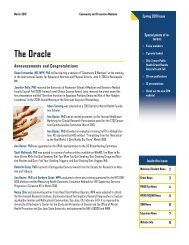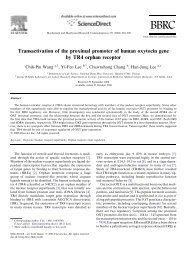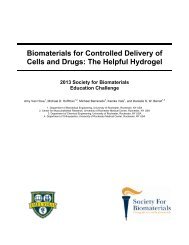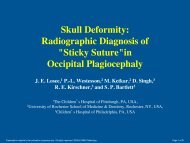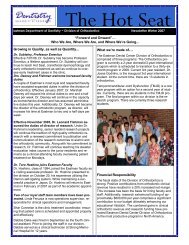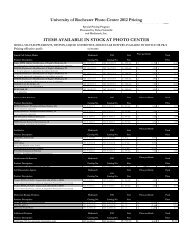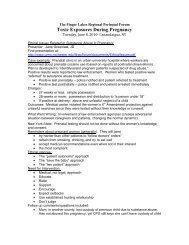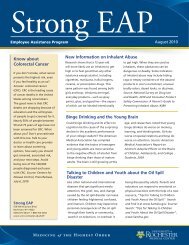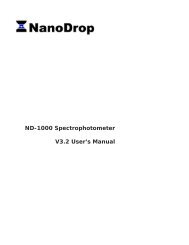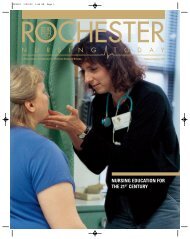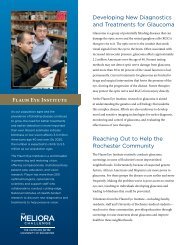rochester nursing - University of Rochester Medical Center
rochester nursing - University of Rochester Medical Center
rochester nursing - University of Rochester Medical Center
- No tags were found...
Create successful ePaper yourself
Turn your PDF publications into a flip-book with our unique Google optimized e-Paper software.
fall 2006SCHOOL OF NURSING | UNIVERSITY OF ROCHESTER MEDICAL CENTER<strong>rochester</strong> <strong>nursing</strong>high-tech/high-touchNew wing ideal for today’s studentsAccelerated programs flourishEntrepreneurship blends <strong>nursing</strong>, business
about <strong>rochester</strong> <strong>nursing</strong> todayNew wing ideal for today’s studentsAccelerated programs flourishEntrepreneurship blends <strong>nursing</strong>, business<strong>rochester</strong> <strong>nursing</strong> todayFall 2006cover photo: Antonio Barbagallo, fotoab.com|todayThe atrium <strong>of</strong> the new Loretta C. FordEducation Wing <strong>of</strong>fers a comfortable, wirelessgathering place.<strong>University</strong> <strong>of</strong> <strong>Rochester</strong>School <strong>of</strong> NursingDeanPatricia Chiverton, EdD, RN, FNAPDean’s Advisory CouncilElizabeth Wetterings Smith, B ‘50Junko Mohri Mills, MS ‘92, PhD ‘00Lisa Norsen, BS ‘77, MS ‘83Richard J. Collins, MD ‘47Marilyn S. Fiske, B ‘67Loretta C. Ford, EdD, HNR ‘00Carolyn Taksen Friedlander, PNP ‘68Patricia High Gorzka, PhD, B ‘61Elaine C. Hubbard, EdD, ANPRobert H. HurlbutMary Moore Insel, MAS ‘81Jean E. Johnson, PhD, FAANKaren O’Hern, MPH ‘96Albert H. Pinsky, AB, JDKaren Webb Sutherland, B ‘61Fay Wadsworth Whitney, PhD, BS ‘61<strong>University</strong> <strong>of</strong> <strong>Rochester</strong><strong>Medical</strong> <strong>Center</strong>Frank InterlichiaAssistant Vice President<strong>Medical</strong> <strong>Center</strong> DevelopmentTeri D’AgostinoDirectorPublic Relations and Communications<strong>University</strong> <strong>of</strong> <strong>Rochester</strong> <strong>Medical</strong> <strong>Center</strong>Elizabeth DiNardoChief Development OfficerSchool <strong>of</strong> NursingDianne MollAssistant Director <strong>of</strong> Developmentand Alumni RelationsSchool <strong>of</strong> Nursing<strong>Rochester</strong> Nursing Today<strong>Rochester</strong> Nursing Today is a biannualpublication <strong>of</strong> the <strong>University</strong> <strong>of</strong> <strong>Rochester</strong>School <strong>of</strong> Nursing in conjunction with the<strong>University</strong> <strong>of</strong> <strong>Rochester</strong> <strong>Medical</strong> <strong>Center</strong>Department <strong>of</strong> Nursing Alumni Relationsand Development and the Department<strong>of</strong> Public Relations & Communications.EditorLori BarretteContributorsPatricia ChivertonElizabeth DiNardoMark McNaneyDianne MollMichael WentzelEditorial AssistantJanet ManganoArt Director/DesignerKathleen MannixFeature PhotographyRichard BakerAntonio BarbagalloKen HuthCommentsWe welcome commentsfrom our readers.All mail should be sent to:Office <strong>of</strong> Development &Alumni RelationsSchool <strong>of</strong> Nursing300 East River RoadPO Box 278996<strong>Rochester</strong>, NY 14627-8996E-mailsonalumni@admin.<strong>rochester</strong>.eduPhone(585) 273-5075 or (800) 333-4428Web sitewww.urmc.<strong>rochester</strong>.edu/son
Inside:32.......... Message from Dean ChivertonFeatures: High-Tech/High-Touch3.......... Dedicating the new Loretta C. FordEducation Wing7.......... Accelerated Programs for Non-Nurseskeeping pace with tech-savvy students12........ <strong>Center</strong> for Nursing Entrepreneurshipmerging <strong>nursing</strong> and business7Departments15........ School News19........ Faculty News22........ Alumni Update12Happenings25........ Graduation 200625<strong>rochester</strong> <strong>nursing</strong> today 1fall 2006
message from the deanSeveral years ago, with a strategic plan as our roadmap, we envisioned a learning environmentthat could bring out the best in every educator, researcher, clinician and student. It wouldintensify the educational experience, foster the exchange <strong>of</strong> ideas and information, and infusethe latest technology to meet the challenges and demands <strong>of</strong> preparing <strong>nursing</strong> pr<strong>of</strong>essionals forthe future <strong>of</strong> care.On April 28, 2006, our vision became a reality as we dedicated the School <strong>of</strong> Nursing’sLoretta C. Ford Education Wing. As the largest expansion in the School’s history, it is atriumph for the <strong>nursing</strong> pr<strong>of</strong>essionals <strong>of</strong> yesterday, today, and tomorrow, and – perhaps mostimportantly – for the countless lives they touch.You’ll fi nd highlights <strong>of</strong> the dedication on the pages ahead. We are deeply grateful toeveryone whose mark is on the growth <strong>of</strong> this School, whether it be this state-<strong>of</strong>-the-artexpansion or the gift <strong>of</strong> your talents, intellect and enthusiasm. Thank you for your support aswe strive to continue meeting the needs <strong>of</strong> the future while respecting and honoring our past.This issue <strong>of</strong> <strong>Rochester</strong> Nursing Today also focuses on ways in which we are using technologyto complement and enhance education. Those <strong>of</strong> us who graduated a decade or more ago, nowliving in a world <strong>of</strong> voice mail, ATMs and online shopping, may be challenged to see howincreased use <strong>of</strong> technology could benefit the very personal, hands-on nurturing that has beenthe hallmark <strong>of</strong> <strong>nursing</strong> practice. While electronics can never replace the warmth and caring <strong>of</strong>a skilled practitioner, our Education Technology Committee is identifying and implementingways to leverage the benefits <strong>of</strong> technology to keep <strong>nursing</strong> education on the cutting edge,interesting and accessible to today’s very technologically sophisticated students. I hope you willenjoy learning how we’re introducing some new technologies into our curriculum and clinicaltraining. We are continuously in search <strong>of</strong> ways to respond to those changes while stayingfocused on improving the quality <strong>of</strong> life.We’ve also included an update on the progress <strong>of</strong> our <strong>Center</strong> for Nursing Entrepreneurship.This innovative program, with roots in the Community Nursing <strong>Center</strong>, shows great promiseas a business incubator and revenue generator, as well as a model for other university-basedentrepreneurship projects.And as you catch up on the latest School news, please be sure to read about Bradford C.Berk, MD, PhD, the new senior vice president for health sciences and CEO <strong>of</strong> the <strong>University</strong><strong>of</strong> <strong>Rochester</strong> <strong>Medical</strong> <strong>Center</strong> and Strong Health, on page 18. Dr. Berk is a <strong>University</strong> <strong>of</strong><strong>Rochester</strong> alumnus who most recently chaired the Department <strong>of</strong> Medicine and directed theCardiovascular Research Institute. While we welcome Dr. Berk to his new role and are eager towork with him, we acknowledge with gratitude the many contributions <strong>of</strong> our previous CEO,C. McCollister Evarts, MD, who remains as a Distinguished <strong>University</strong> Pr<strong>of</strong>essor.If you were not able to join us in the spring, I hope you will plan to join us for Reunion,October 12-14. In addition to enjoying our programs and catching up with colleagues andformer classmates, we’ll be happy to take you on a tour <strong>of</strong> our new wing and courtyard. Watchyour mail for Reunion details, or you can call toll-free at (800) 333-4428 or register online atwww.urmc.<strong>rochester</strong>.edu/son/alumni/reunion.cfm.Thank you for your continued encouragement and support.Sincerely,Patricia Chiverton, EdD, RN, FNAPDean and Pr<strong>of</strong>essor,<strong>University</strong> <strong>of</strong> <strong>Rochester</strong> School <strong>of</strong> NursingVice President, Strong Health Nursing2 <strong>rochester</strong> <strong>nursing</strong> todayfall 2006
tech-touch: Dedicating the Loretta C. Ford Education Wingschool <strong>of</strong> <strong>nursing</strong> celebrates opening<strong>of</strong> new high-tech education wingfuture <strong>of</strong> care campaign donors acknowledged for their supporttech-touchThe School <strong>of</strong> Nursingdedicated the Loretta C. FordEducation Wing <strong>of</strong> HelenWood Hall on April 28,2006 with a series <strong>of</strong> events,including a symposium,ribbon-cutting ceremony andgala banquet.The new wing, namedfor Dean Emerita Loretta“Lee” Ford, RN, PNP,EdD, who served as theSchool’s dean from 1972 to1986 and is internationallyknown for creating the role<strong>of</strong> the Nurse Practitioner,is part <strong>of</strong> an $8.1 millionexpansion and renovationproject that will help theSchool <strong>of</strong> Nursing increasestudent enrollment, boosttechnological capabilities andenhance research.Patricia Chiverton,EdD, RN, FNAP, dean<strong>of</strong> the School <strong>of</strong> Nursing,called the new wing “a trulyhistoric moment.”“The Loretta C. FordEducation Wing means wecan educate more nurses andnurse leaders at the master’sand doctoral level, whichultimately means betterpatient care,” Chivertonsaid. “But it also means wewill have more opportunitiesfor unique programs andfor taking business ideas fornew models <strong>of</strong> care to theLeading the Dedication Ceremony are, from left, ribbon-cutters C. McCollister Evarts, MD, Congresswoman Louise Slaughter, Dean Patricia Chiverton,Dean Emerita Loretta Ford, <strong>University</strong> President Joel Seligman, former <strong>University</strong> President Tom Jackson, Future <strong>of</strong> Care Campaign Chair Robert Hurlbut,and 2006 graduate Adam Tatemann.<strong>rochester</strong> <strong>nursing</strong> today 3fall 2006
The Loretta C. Ford wing is a 28,000-square-foot expansion that includes four spacious classrooms,an auditorium that seats 170 people, a seminar room and an atrium. The wing’s wireless and smartclassroom technology and video conferencing capability will facilitate student learning. Much <strong>of</strong>the first floor <strong>of</strong> Helen Wood Hall also was renovated as part <strong>of</strong> the $8.1 million project.marketplace.”Ford was humbly gratefulfor the honor and expressedher life-long desire tosupport advances in <strong>nursing</strong>education and practice.“For years, my husbandand I have invested in humanresources by supportinginstitutions that educatenurses and teachers,” Fordsaid. “Frankly, I wasn’t tooenamored with the idea<strong>of</strong> having my name on abuilding. But as (<strong>University</strong>)President ( Joel) Seligmanobserved, ‘Named facilitiesare inspirations for futuregenerations.’ So, I thoughtthat if this educationaladdition to the School<strong>of</strong> Nursing improves thelearning environment,attracts talented students andfaculty, and demonstrates tothe world that this school is avital, energized, and growingenterprise I would be pleased.“Actually, I have beenmore than delighted withthe outcome,” she added.“Since the facility has opened,several faculty have told mehow thrilled they are withthe new, fully equippedclassrooms.”Ford expressed hergratitude to all who wereinvolved in the building anddedication.“Thanks to DeanPat Chiverton for her visionand tenacity, Robert Hurlbut,the chairman <strong>of</strong> the Future<strong>of</strong> Care Campaign for hisskill in fundraising, CaroleRose whose guiding hand– and I’m sure sometimes herfist – brought the buildingto completion, and theDevelopment <strong>of</strong>fice staff fortheir monumental efforts inevery phase <strong>of</strong> the project,”she said.Dedication day includeda symposium on the NursePractitioner movement,<strong>Rochester</strong>’s role as a leaderin the movement and trendsin the pr<strong>of</strong>ession, followedby a special lunch for invitedguests.Chiverton and Fordaddressed a crowd atthe afternoon ribboncuttingceremony. Alsoparticipating were JoelSeligman, president <strong>of</strong> the<strong>University</strong> <strong>of</strong> <strong>Rochester</strong>;C.C. McCollister “Mac” Evarts,MD, distinguished Univeristypr<strong>of</strong>essor; Robert H. Hurlbut,chairman <strong>of</strong> the School’sFuture <strong>of</strong> Care Campaign;U.S. Rep. Louise Slaughter,Joanne Empey Fiaretti, B ’56,with Dean Patricia Chiverton.From left, Mary Wilde, William Ford, Loretta Ford, Rachel Kraus andAmanda Coyle.Karen Webb Sutherland, B ’51 (left) <strong>of</strong> the Dean’s Advisory Council presentsthe School’s Health and Humanity Award to Johnson and Johnson’s AndreaHigham for their Campaign for Nursing’s Future.4 <strong>rochester</strong> <strong>nursing</strong> todayfall 2006
elaine c. hubbardcenter for<strong>nursing</strong> researchon agingHighlighting the LorettaC. Ford Education Wingcelebration was the dedication<strong>of</strong> the Elaine C. Hubbard<strong>Center</strong> for Nursing Researchon Aging. Described byDean Patricia Chivertonas “a woman <strong>of</strong> warmthand extraordinary caring,”Elaine C. Hubbard, EdD,RN, ANP, was recruited tothe School <strong>of</strong> Nursing by Fordto serve as its fi rst associatedean <strong>of</strong> undergraduatestudies, a role in which sheserved from 1975 to 1981.During her tenure in<strong>Rochester</strong>, Hubbard was thearchitect and fi rst director<strong>of</strong> the School’s CommunityNursing <strong>Center</strong>, whichlaid the foundation fortoday’s <strong>Center</strong> for NursingEntrepreneurship. Hubbard’spassion for primary care andcare <strong>of</strong> the elderly has beena hallmark <strong>of</strong> her career.Though she retired in 1990,she remains an active advisor,valued colleague and friendto the School.“It is my dream thatthe <strong>Center</strong> for NursingResearch on Aging willbecome a national model forscientific research that willfacilitate the identification<strong>of</strong> preventive strategiesand activities for groups <strong>of</strong>people,” said Hubbard. “Thiswill require the use <strong>of</strong>From left, Victoria Hines, Jean Garling, Dean Patricia Chiverton, ElaineHubbard and Nancy Watson cut a ribbon to celebrate the opening <strong>of</strong> the ElaineC. Hubbard <strong>Center</strong> for Nursing Research on Aging.existing resources, in additionto the development <strong>of</strong> somethat are new and innovative,resulting in more self-care,better functioning, greaterindividual freedom, andless demand for health caredollars.”The <strong>Center</strong> will bolsterthe School’s long-standingcommitment to servingthe elderly by identifyingand implementing methods<strong>of</strong> assisting older peoplein coping and living withthe psychological andphysiological changesassociated with aging. rnA highlight <strong>of</strong> the Loretta C. Ford Education Wing is The Jacoby Board Room.Guests celebrate at a special luncheon prior to the Dedication Ceremony.and a representative fromSenator Hillary Clinton’s<strong>of</strong>fice. Highlightingthe ceremony was theannouncement by Evarts <strong>of</strong>Chiverton’s appointment asthe Pamela Klainer Chairfor the <strong>Center</strong> for NursingEntrepreneurship.The celebration continuedwith a crowd <strong>of</strong> over 200 atan evening banquet at CasaLarga Vineyards. There, theSchool presented its Healthand Humanity Award toJohnson & Johnson Co. forits “Campaign for Nursing’sFuture,” a national effortto attract more people into<strong>nursing</strong> and to develop more<strong>nursing</strong> educators.“The completion <strong>of</strong> thebuilding and its dedicationin April provided anopportunity to celebratewith family and friends,former students and facultycolleagues from UR andaround the nation andCanada,” Ford added. “Itwas a celebration to end allcelebrations, starting withscholarly historical reports,a march down memory lanewith some pioneering alumniand faculty, and culminatingwith a Roaring ’20s dress-upparty at the Casa Larga. Noone could have been morepleased than my husbandand I. Our heartfelt thanksto those who made all thispossible.” rn<strong>rochester</strong> <strong>nursing</strong> today 5fall 2006
Above: Dedication day included a symposium on the Nurse Practitionermovement, <strong>Rochester</strong>’s role as a leader in the movement and trends inthe pr<strong>of</strong>ession. The afternoon’s speakers included: Julie A. Fairman,RN, PhD, FAAN, chair <strong>of</strong> the graduate faculty <strong>of</strong> the <strong>University</strong><strong>of</strong> Pennsylvania School <strong>of</strong> Nursing; Joan E. Lynaugh, RN, PhD,FAAN, director emerita <strong>of</strong> the Barbara Bates <strong>Center</strong> for the Study<strong>of</strong> the History <strong>of</strong> Nursing at the <strong>University</strong> <strong>of</strong> Pennsylvania and heralumni panel; Carolyn A. Williams, RN, PhD, FAAN, dean <strong>of</strong> the<strong>University</strong> <strong>of</strong> Kentucky School <strong>of</strong> Nursing; and Daryl Sharp, RN,PhD, CS, NPP, coordinator <strong>of</strong> the Psychiatric Mental Health Program<strong>of</strong> the <strong>University</strong> <strong>of</strong> <strong>Rochester</strong> School <strong>of</strong> Nursing.Above and far left: Guests celebrate atthe Future <strong>of</strong> Care Gala on April 28at Casa Larga Vineyards in Fairport.At left: Ginny Ryan, Channel 13news anchor, was emcee for the Gala.Bottom: School <strong>of</strong> Nursing staffand friends dress up for theRoaring ’20s spectacular occasion.6 <strong>rochester</strong> <strong>nursing</strong> todayfall 2006
tech-touch: Accelerated Programsaccelerated programs keeping pacewith tech-savvy studentsford wing ideal for today’s learners, tomorrow’s <strong>nursing</strong> pr<strong>of</strong>essionalstech-touchAccelerated Program students(from left) Diane O’Shaughnessy,Tracee Tomlinson and MichaelFisher take advantage <strong>of</strong> the wirelessenvironment while studying inthe atrium <strong>of</strong> the Loretta C. FordEducation Wing.With the largest class inits five-year history underway, leaders <strong>of</strong> the School<strong>of</strong> Nursing’s AcceleratedPrograms for Non-Nursesare introducing advancedtechnologies to meet theneeds <strong>of</strong> its diverse andsophisticated learners. State<strong>of</strong>-the-artfacilities in theSchool’s new Loretta C.Ford Education Wing, arean optimal setting for toolslike iPods, personal digitalassistants, videostreaming,and life-like patient simulatorsto complement traditionalteaching methods, improveaccess and lend flexibilityto learning.“Technology is one and education.”www.dementia<strong>nursing</strong>.orgmethod we are using toimprove our learning andteaching that will ultimatelyimprove patient outcomes,”said Rita D’Aoust, MS,RN, ACNP, senior associatepr<strong>of</strong>essor and director <strong>of</strong> theAccelerated Bachelor’s andMaster’s Programs for Non-Nurses. “It also helps us staycompetitive in attracting thebest and brightest studentsto our program. Yet, evenwith the best technology,we’re not about quicklyproducing a nurse, but ratherdeveloping future leaders atthe bedside, and in researchAccelerated programstudents have degrees in non<strong>nursing</strong>fields and participatein an intensive curriculumthat leads to a bachelor <strong>of</strong>science degree in <strong>nursing</strong> andeligibility for pr<strong>of</strong>essionalregistered nurse licensingexaminations.Because they come fromvaried backgrounds – manyaccomplished in other careersbefore making the shift to<strong>nursing</strong> – most come to theprogram with technologysavvy. Their range <strong>of</strong>education and experience<strong>rochester</strong> <strong>nursing</strong> today 7fall 2006
Senior Teaching Associate Joanne E. Layton runs a training scenario using SimMan for Accelerated Program graduate Adam Tatemann.results in a student populationwith a wide array <strong>of</strong> learningstyles.“Our job is to recognizethat and determine how wecan help them to learn andsucceed in the program,” saidD’Aoust. “While technologycan never replace thehumanistic, caring nature<strong>of</strong> <strong>nursing</strong> and <strong>nursing</strong>education, it can augmentlearning and help preparestudents for today’s healthworld. In response, westarted changing the way wedo business by building atechnology infrastructure thatwill allow students to accesswhat they need whereverthey are, whenever they needit, in a format that worksfor them.”That infrastructure,spearheaded by an EducationTechnology Committee,includes an internet-basedlisting <strong>of</strong> educationalresources for students andfaculty, capability to produceor convert resources to digitalmedia so they can be accessedby computer, computers forclinical and educational skillslabs so students can watchand practice simultaneously,and enhancement <strong>of</strong>resources available throughthe <strong>University</strong>’s EdwardG. Miner <strong>Medical</strong> Library.Additionally, wirelesscapabilities in the School’snew wing permit internetaccess with laptop computerswithout the need to connectto any cables or outlets.computerconnectionsUsing a computer programcalled “Blackboard,” studentscan access numerous courserelatedresources, includingclinical guidelines, lectures,tests and class assignments,case studies and othertools, to augment their timein classes and on clinicalrotations, or for distancelearning.“We are currently trialingseveral online lectures tohelp us determine wherethey might best be used andhow they can complementother components <strong>of</strong> variouscourses,” said D’Aoust. “Withthe new wing’s fantastictechnology, we can tapelectures, digitalize them andmake them available via acourse Web page, so they canbe watched on a computer oreven an iPod,” said D’Aoust.“It’s a great resource forstudents who need repetitionand review for exams, orwho may be absent from aclass due to illness or weatherconditions.”Accelerated bachelor’sstudent Diane O’Shaughnessygot a taste <strong>of</strong> this technologyduring her summer HealthAssessment, Genetics, andNursing Science courses.Class lectures were posted onBlackboard and she was ableto bring a laptop to class, logonto the wireless network,download the slides at thebeginning <strong>of</strong> class, and thentype notes directly on her8 <strong>rochester</strong> <strong>nursing</strong> todayfall 2006
SimMan provides realistic patient care experiences for<strong>nursing</strong> training.tech-touchcopy <strong>of</strong> the presentationwhile recording the lectureon her laptop.“This allowed me to nothave to lug any notebooksor books to class…to havemy entire course with meeverywhere I brought mylaptop,” O’Shaughnessysaid. “I could play back mylectures during my commuteto study efficiently, search forinformation instantaneouslyusing an electronic tool ratherthan rifl ing through pagesand pages <strong>of</strong> paper, and savetime by not having to fi leand keep track <strong>of</strong> a bunch <strong>of</strong>paper notes.”Faculty members aretesting the use <strong>of</strong> iPods forthis purpose, due to theirpotential to make coursematerials more accessibleand portable.“We’re piloting the podcastidea with one clinical coursethis semester and will expandit to a research course in thefall,” D’Aoust said. Podcastswould be digital videos <strong>of</strong>lectures or presentations thatstudents can watch from theircomputers or download toan iPod to watch anywhere.“We may be among the fi rstin the country to use iPodsand podcasts in our <strong>nursing</strong>curriculum,” she said, addingthat iPods can help maximizethe use <strong>of</strong> travel time as wellas providing audiovisuallearning for critical lectures.patientsimulationHelping students gainvaluable clinical experienceare two sophisticated patientsimulators that can mimichuman medical conditions.They provide opportunitiesfor student nurses to practiceskills with life-like reactions,without risk.Known as SimMan, thesehigh-tech mannequins areprogrammed by faculty withpatient health issues such asdiabetes, breathing problemsand cardiac arrest to providestudent nurses with realisticscenarios to which they canrespond.“SimMan can beprogrammed for a cardiacarrest in which students mustrespond and intervene in alife-like simulation, completewith cardiac rhythms, oxygensaturation readings, bloodpressure, and the like,”said D’Aoust.“We improve patientsafety by simulating criticallife-threatening experiencesin the laboratory setting sothe fi rst time isn’t a real-lifesituation. Students learnto deal with anxiety, quickdecision-making, and workingas part <strong>of</strong> an interdisciplinaryteam,” she said. “Students areable to review a videotape<strong>of</strong> the scenario, review theiractions, and reflect on whatworked well and what couldbe improved. This allows thestudent to improve knowledgeand skills while developingconfidence.”The Institute <strong>of</strong> Medicineidentified five competenciesfor the education <strong>of</strong> all healthpr<strong>of</strong>essionals: deliveringpatient-centered care, workingas part <strong>of</strong> interdisciplinaryteams, practicing evidencebasedmedicine, focusing onquality improvement, andusing information technology.“Simulators can extendcritical thinking developmentand skills by presentingserious or uncommon medicalproblems, and allowing themto develop completely,” saidBrian Thomas Graves,RN, MS, ACNP, APRN-BC, senior teaching associateand director <strong>of</strong> the AcuteCare Nurse PractitionerProgram. “Even if errorsin management are made,students can experience fi rsthandall possible outcomesinstead <strong>of</strong> just reading aboutthe consequences <strong>of</strong> patientmanagement in a textbook orhearing about the experiencesecond hand from a clinicalinstructor, said Graves. Thisexposure <strong>of</strong>fers a broaderand more consistent trainingprogram that will resultin a more highly trained,developed, and skilled nurseor nurse practitioner enteringthe workforce.”The School collaborateswith <strong>nursing</strong> practice atStrong Memorial andHighland hospitals to usethis technology for studenttraining, <strong>nursing</strong> orientationand continuing education.point-<strong>of</strong>-caretechnologyDuring the summer <strong>of</strong> 2006,the School introduced the use<strong>of</strong> personal digital assistants,or PDAs, in clinical training.These hand-held electronicdevices put resources likedrug handbooks and clinicallaboratory reference valuesand interpretations atinstructors’ fi ngertips whilethey are teaching at thebedside.Clint Taft, MS, RN,instructor <strong>of</strong> clinical <strong>nursing</strong>,was introduced to the PDAwhile teaching at MonroeCommunity College.“Students used it to lookup their patients’ diagnosis,medication, <strong>nursing</strong> processinformation, diagnostictesting and many otherthings,” said Taft.In time, PDA technologywill be more widely used toenable students to enter datafor patient assignments while<strong>rochester</strong> <strong>nursing</strong> today 9fall 2006
passport health‘on demand’ lectures: Check us out onlineTo view a sample School <strong>of</strong> Nursing lecture online, please visit http://video.son.<strong>rochester</strong>.edu/Genetics-Lecture/in clinical, and later upload itto their computers for use intheir training.“In the ICU, the PDAhas really changed the wayI practice <strong>nursing</strong>,” Taftadded. “There are times thattext books are not availableon the unit and looking upinformation becomes difficult,to say the least. With aPDA, valuable informationis literally at your fi ngertips.Many <strong>of</strong> my colleagues askto use it for their patientassignments, and physicianshave asked to borrow itas well.”a step ahead“One thing is clear abouttoday’s students,” saidD’Aoust. “As soon as weintegrate a new technologyinto our program, it isconsumed, so we arechallenged to continuethinking about and planningfor the next step so that, inaddition to attracting studentsto our excellent programsand renowned faculty, wedraw them in as a technologycenter that is always astep ahead.”On the horizon areadvances in telehealth thatare likely to expand at theSchool as diagnostic abilitiesadvance and technologicalsolutions are employed tocombat the <strong>nursing</strong> shortage.“These initiatives areonly the beginning. We needto develop an educationtechnology or simulationtechnology center for usewith all levels <strong>of</strong> <strong>nursing</strong>education, including nursepractitioners and continuingeducation, to best prepare ournurses for the future <strong>of</strong> care,”D’Aoust added. rnacceleratedprograms grow,attract diversestudentsSince it fi rst enrolled studentsfive years ago, the School<strong>of</strong> Nursing’s AcceleratedPrograms have blossomed insize and reputation. In May,its largest class – 123 students– embarked on their journeyto an accelerated bachelor’sdegree.D’Aoust and her colleagueshave consulted nationallywith other <strong>nursing</strong> schoolsinterested in launchingaccelerated programs.And <strong>Rochester</strong>’s programcontinues to attract highquality, diverse applicantsfrom across the countryand from a wide range <strong>of</strong>educational and careerbackgrounds.“We have studentsapplying to this programfrom every occupationimaginable,” said ElaineM. Andolina, MS, RN,director <strong>of</strong> Admissions forthe School <strong>of</strong> Nursing. “Some<strong>of</strong> our recent graduatesinclude a Roman Catholicpriest, a private investigator,a retired lieutenant colonelfrom the Air Force who hadflown 48 missions in DesertStorm, a Chinese neurologist,and a woman who was herdissertation shy <strong>of</strong> a PhDin neuroanatomy. Studentscome from a variety <strong>of</strong> places,too, including India, Hawaii,Ethiopia, Canada, California.They come to us withmaster’s degrees in education,divinity, chemicalengineering, anthropology.Together they bring a wealth<strong>of</strong> perspectives to us and foreach other.”“In a short time, ourprogram has achievednational recognition,”said D’Aoust, creditingthe School’s alumni anddonors who have embracedit with their support andencouragement. “We couldnot operate these programswithout having thoseresources.“We are particularlygrateful for the support <strong>of</strong>the Helene Fuld HealthTrust grant, HSBC BankUSA, Trustee, the singlemostimportant source <strong>of</strong>scholarship funds for ouraccelerated students.”In addition, a <strong>nursing</strong>education grant from theUnited States Department <strong>of</strong>Health and Human Services,Bureau <strong>of</strong> Health Researchand Service Administration,has been instrumental inproviding resources forcurriculum developmentin the Accelerated NursingProgram, such as theeducation technologyinitiatives. However, furthersupport is needed to continuethe work that has beeninitiated.The best way to appreciatethe diverse backgrounds<strong>of</strong> the School’s acceleratedstudents is by getting to knowthem. Here are a few <strong>of</strong> theirstories.Mike FisherWhen Mike Fisher joined theSchool <strong>of</strong> Nursing in 2004,it was to apply his computerscience degree and experienceas a system administrator andWeb developer. Originallyfrom the Cleveland, Ohioarea, Fisher moved to<strong>Rochester</strong> in 1997 to earna bachelor’s degree from<strong>Rochester</strong> Institute <strong>of</strong>Technology.“At the time, I picturedmyself spending my careerworking with computersand thought it would suitme well,” said Fisher. “Butafter awhile I found out thatwas a wrong perception.Working at the School <strong>of</strong>Nursing, I have developeda greater understanding <strong>of</strong>how my work can be more10 <strong>rochester</strong> <strong>nursing</strong> todayfall 2006
customer focused. I’ve hadthe opportunity to participatein groups that are looking attechnology for educationalpurposes, and it helped meto see how my technologybackground, combined with<strong>nursing</strong> training, could haveendless possibilities.”Fisher’s computerbackground has beenessential to the expansion <strong>of</strong>computer technology at theSchool, according to D’Aoust,who asked Fisher to considerenrolling in the program,to enhance his ability toapply technology in <strong>nursing</strong>settings.“For example, with ourpatient simulator…ratherthan simply programming itfor scenarios and case studies,I will understand theircomplexities and the possibleresponses to them,” Fishersaid.Fisher is continuing in hisposition at the School whileenrolled in the acceleratedbachelor’s degree program asa part-time student.A beneficiary <strong>of</strong> the FuldScholarship program, aftercompleting his <strong>nursing</strong>degree Fisher plans to usehis combined degrees to helpthe School develop betterprocesses for integrating<strong>nursing</strong> and technology.Diane O’ShaughnessyAfter 15 successful years ina fast-paced business world,Diane O’Shaughnessy wasready to start over. Economicand personal factors led thesingle mother to a careercounselor with the goal <strong>of</strong>fi nding meaningful workwith the flexibility to be homewhen her son and daughtergot <strong>of</strong>f the school bus.An exemplary student,O’Shaughnessy earned anassociate’s degree in electricalengineering from <strong>Rochester</strong>Institute <strong>of</strong> Technology, anda bachelor’s in biology fromSUNY Empire State College.For 10 years she worked atautomating human resourcessystems for Bausch and Lombbefore launching a consultingcareer. When economicpressures resulted in theloss <strong>of</strong> her largest contract,she faced the prospect<strong>of</strong> extensive travel andendless hours to keep herbusiness afloat.Sessions with a careercounselor reignited her fadedinterest in medicine.“Nursing really seemedto fit my needs at this pointin my life,” O’Shaughnessysaid. She took prerequisiteclasses to test the waters atvarious <strong>nursing</strong> programs in<strong>Rochester</strong>.“I was very impressed withthe <strong>University</strong> <strong>of</strong> <strong>Rochester</strong>and the Accelerated Programwas a good fit for my needs.It’s competitive and veryintense but I liked the factthat I don’t have to go for fouryears without working.”O’Shaughnessy found<strong>nursing</strong> appealing alsobecause it would give heran “opportunity to make adifference in the world.” Shehopes to work as an intensivecarenurse and eventuallycontinue school to become anurse anesthetist.With the fi rst few months<strong>of</strong> the program under herbelt, O’Shaughnessy is certainshe’s made the right decisionfor her future.“It took some guts, butI’m so glad I did it now. Ilove it. It’s very competitiveand the caliber <strong>of</strong> studentsin the program is incredible;it’s a very intelligent, drivengroup.”O’Shaughnessy isbenefiting from partialfunding through the FuldScholarship program.Adam TatemannRecent graduate AdamTatemann embarked on asix-month ICU orientationat Highland Hospital aftercompleting his acceleratedbachelor’s degree in May2006. The Vermont nativeearned a bachelor’s inbiology from the <strong>University</strong><strong>of</strong> Vermont, where he wasoriginally enrolled as apre-med major in a clinicalneuropsychiatry track.Tatemann worked inOregon for two yearswith children with autism,providing instruction onsocial skills, academics skills,and coping techniques.Following that, he movedto New York to work withautistic youth, providingindividualized instructionusing applied behavioralanalysis.Taking a break fromthat, Tatemann worked fora while as a carpenter beforeenrolling in a psychologyprogram at SUNY Brockport.After giving thought to longtermcareer goals, he decidedthat <strong>nursing</strong> would providechallenging opportunitiesand good job security andenrolled in the AcceleratedProgram.“It was an adjustmentbut I found my previouseducation and workexperience prepared me well,”said Tatemann. “I enjoyedlearning in an environment<strong>of</strong> students from variousbackgrounds, where peopleapproach problems fromdifferent perspectives. It wasa rigorous full-time programand sometimes tough but Iam very excited to be in the<strong>nursing</strong> pr<strong>of</strong>ession.”Tatemann’s goals includegaining experience in a widerange <strong>of</strong> <strong>nursing</strong> disciplines,earning an advanced degree,and eventually teachingat the university level andpublishing original research.Tracee M. TomlinsonAs an economics majorat Spelman College inAtlanta, Georgia, Tracee M.Tomlinson became involvedin health advocacy in hercommunity and learned <strong>of</strong>the great need for nurses. Asa member <strong>of</strong> SHAPE, StudentHealth Associates and PeerEducators, she was exposedto health care fields. Withguidance and support fromSpelman’s career planning<strong>of</strong>fice, Tomlinson considereda career in <strong>nursing</strong> and beganresearching <strong>nursing</strong> educationprograms.“I was impressed withall the <strong>University</strong> <strong>of</strong><strong>Rochester</strong> had to <strong>of</strong>fer me;it pretty much sold itselfto me,” Tomlinson, a FuldScholarship-supportedstudent, said. “It turns out itwas one <strong>of</strong> the best decisions Ihave ever made. I really lovethe program.”Tomlinson hopes t<strong>of</strong>ocus her <strong>nursing</strong> career onwomen’s health care andeventually plans to pursueher studies to become afamily nurse practitioner.Her long-term <strong>nursing</strong>goal is to complete a doctoralprogram. rntech-touch<strong>rochester</strong> <strong>nursing</strong> today 11fall 2006
tech-touch: <strong>Center</strong> for Nursing Entrepreneurshipcenter for <strong>nursing</strong> entrepreneurshipmerges <strong>nursing</strong> and businessIt was a grassroots idea: a<strong>nursing</strong> faculty practice thattargeted specific communityhealth needs and builtprograms and services tomeet those needs. Firstand foremost, it was aninnovative way to improvehealth outcomes. Secondly, itwas a way to stretch <strong>nursing</strong>beyond traditional settingsand into new businessventures. In time, the School<strong>of</strong> Nursing’s <strong>Center</strong> forNursing Entrepreneurshipwas born.Leading the way in thiseffort today are DonnaTortoretti, RNC, MS,CMAC, chief executive<strong>of</strong>ficer, and a seasonedgroup <strong>of</strong> faculty and staffwith excellent clinicalpractice, entrepreneurialand business skills.The <strong>Center</strong> – the fi rst <strong>of</strong>its kind in the nation – nowconsists <strong>of</strong> several sustainablebusinesses, a research anddevelopment center, and abusiness incubator.“We take businessconcepts, flesh them out interms <strong>of</strong> business viability,incubate them, and whenthey’re ready to leave theDonna Tortorettinest, we give them wings,”said Tortoretti.The CNE’s most recentsuccess and fi rst spin-outcorporation is the NationalForensic Nursing Institute, anengine for economic growthand expanded opportunitiesfor nurses as well as otherhealth care pr<strong>of</strong>essionals.“We brought in the concept<strong>of</strong> a company whose focuswould be forensic <strong>nursing</strong>,with the mindset that itcould be a pr<strong>of</strong>itable businessventure. After a year <strong>of</strong> hardwork, it has become thesuccessful hallmark for the<strong>Center</strong> in the entrepreneurialmarketplace,” said Tortoretti.origins incommunity<strong>nursing</strong> centerIn the mid-1990s, the idea<strong>of</strong> a faculty practice forthe School <strong>of</strong> Nursing’sinstructors moved froma traditional focus to onethat could provide the samehealth interventions in thecommunity but be sustainableat the same time.“We were looking toestablish new models <strong>of</strong>care that would expandupon routine disease statemanagement by providing abasis for community healthpromotion and individualpredictive health riskreduction,” explained School<strong>of</strong> Nursing Dean PatriciaChiverton, ED, RN, FNAP.“Arising from that goal wasthe School’s CommunityNursing <strong>Center</strong>.”The Community Nursing<strong>Center</strong> has since grown intonine distinct lines <strong>of</strong> business.Among them are the <strong>Center</strong>for Lifelong Learning,Passport Health, HealthCheckpoint, Nutrition andWeight Management <strong>Center</strong>,Influenza and PneumoniaPrevention Program, School-Based Health Services,Health Care Consultingand Community PracticePartnerships, Telehealthand Practice EnhancementServices, in addition to theNational Forensic NursingInstitute.“Over the years, programsurpluses from the CNChave helped fund the School<strong>of</strong> Nursing’s initiatives,”Chiverton said. “However,like most businesses, theFrom left, Pamela Smith, William Russell, Mark McNaney and Eva Bellis review business results in the <strong>Center</strong>’shigh-tech conference room.12 <strong>rochester</strong> <strong>nursing</strong> todayfall 2006
tech-touchMarlene Downs, associate director for Health Checkpoint, demonstrates the benefi ts <strong>of</strong> health maintenance and use <strong>of</strong> the kiosk to Karen Kirkey.CNC is subject to the samedynamics as the market.Most notably, we have hadseveral consecutive yearswhen flu vaccine has been intremendously short supply.We were required to executea modified plan to sustainour business operations andthanks to a resourceful teamthat can think quickly ontheir feet, we were able toovercome these obstacles andcontinue to provide a neededservice to the community.”With an eye towardbusiness volume, capacityutilization and breakevenanalyses, Tortoretti, and theCommunity Nursing <strong>Center</strong>staff have recently managedto generate surpluses acrossall business lines for thefi rst time since the CNC’sinception.“This has all been possiblewith the entrepreneurialspirit, pr<strong>of</strong>essional talentsand ingenuity <strong>of</strong> our highlydedicated team.” Tortorettisaid. “This has been anextraordinary year!”recognitionby kauffmanfoundationLate in 2003, the EwingMarion KauffmanFoundation recognized the<strong>University</strong> <strong>of</strong> <strong>Rochester</strong>by awarding the School<strong>of</strong> Nursing, The WarnerSchool, the College <strong>of</strong> Arts,Sciences and Engineeringand the Eastman School <strong>of</strong>Music with $3.5 million ingrants. This award was givento only eight institutions <strong>of</strong>higher learning across theUnited States to engrainentrepreneurship into theiracademic programs.“We are proud to bethe fi rst school <strong>of</strong> <strong>nursing</strong>to receive KauffmanFoundation funding,” saidTortoretti. “The Foundationhas recognized the value<strong>of</strong> nurse entrepreneurship,and we have respondedby restructuring theCommunity Nursing <strong>Center</strong>into the <strong>Center</strong> for NursingEntrepreneurship.”uniquepartnershipsThrough the years,partnerships have evolvedfrom practice contracts forfaculty to several businesseswhose scope spans the region,with <strong>of</strong>fices in <strong>Rochester</strong>,Canandaigua and Syracuse.“We are now reaching anational level with ourcorporate wellness program,Health Checkpoint. This isa health promotion programwith a focus on businessreturn-on-investment vialeveraging human capital.Our collaborations extendbeyond <strong>nursing</strong> and healthcare. We are in the midst<strong>of</strong> establishing national andinternational partnerships<strong>rochester</strong> <strong>nursing</strong> today 13fall 2006
with respected leaders in theareas <strong>of</strong> academics, businessand entrepreneurship,” saidTortoretti. “We are activelyinvolved with the <strong>Center</strong> forAging Services Technologies(CAST) in Washington,DC, and through ourinvolvement in the AmericanTelemedicine Association arecollaborating with LivingIndependently, the developer<strong>of</strong> QuietCare ® , to study andevaluate new models <strong>of</strong> careacross the aging spectrum.And our work with MedifactsInternational has positionedus on the global stage.”“The <strong>Center</strong> for NursingEntrepreneurship is proudto have a wealth <strong>of</strong> involvedalumni and friends who serveon the <strong>Center</strong>’s AdvisoryBoard, and project steeringcommittees and who havebeen active in our recent spin<strong>of</strong>f,as well,” said Chiverton.“Our relationshipswith the community andthe School’s alumni aresignificant to our success,”added Tortoretti. “With PamKlainer’s direct involvementin planning and funding, the<strong>Center</strong> was able to establishan endowed chair position.next stepsThe <strong>Center</strong> for NursingEntrepreneurship iscurrently undergoing arebranding effort and Website development, funded bya John and Jayne SummersFoundation grant.“We could not besuccessful without thecontinued interest,William Russell, director <strong>of</strong> Passport Health, conducts a meeting with travelmedicine clients.involvement and investment<strong>of</strong> our alumni and friends,”Chiverton said. “They are thefoundation to our establishingboth the <strong>Center</strong> for NursingEntrepreneurship and ourrecent building renovationsand expansion.”“The future is wide openand we are only limited byour imaginations,” Tortorettisaid. “We want to become avital part <strong>of</strong> the effort aimedat refueling the economicengine <strong>of</strong> our communityand country. When an ideais presented to our board,we work with the sponsor todevelop it along traditionalbusiness planning criteria.However, that’s where the‘traditional’ part ends. Onceconceived and incubated, abusiness blossoms and theoriginator is transformed intoan entrepreneur. We couldn’thave been happier to spin-<strong>of</strong>fthe National Forensic NursingInstitute, and provide supportto the Entrepreneur andfounder, Russell Rooms,MSN. The timing wasperfect.”“I see a solid frameworkon which to expand,” saidTortoretti. “The CNC andnow the <strong>Center</strong> for NursingEntrepreneurship hasproven it can be successful– programmatically,operationally and fi nancially.But the key to everysuccessful business is basic‘blocking and tackling.’We are in the business <strong>of</strong>business, and are creatingopportunities for students,faculty, alumni.” rnPamela Smith, director <strong>of</strong> the <strong>Center</strong> for Lifelong Learning, reviews upcomingcourses with Margaret Miller.14 <strong>rochester</strong> <strong>nursing</strong> todayfall 2006
news <strong>rochester</strong> <strong>nursing</strong> newsschool wins esagold awardThe <strong>University</strong> <strong>of</strong> <strong>Rochester</strong>School <strong>of</strong> Nursing is theonly <strong>nursing</strong> school in NewYork state to earn an EmpireState Gold Award, whichrecognizes innovation andgrowth at the School. EmpireState Advantage, Inc. is apublic/private partnershipformed under the auspices<strong>of</strong> the Governor’s Officeto help build economiccompetitiveness and improvethe quality <strong>of</strong> life in the state.“We found a visionaryleadership team, acollaborative culture, and awell-prepared faculty that isfocused on student success,”said George Hansen,executive director <strong>of</strong> EmpireState Advantage (ESA). ESAconducts on-site reviews <strong>of</strong>organizations and businessesthat are based on nationalquality standards.“We found strongcommunity and alumnisupport, extensivepartnerships and a high level<strong>of</strong> fi nancial responsibilityand stability,” Hansen said.“And we found a history overrecent years <strong>of</strong> innovativenew programs and growththat will position the School<strong>of</strong> Nursing as a vital resourcein improving healthcaredelivery, both within andbeyond the greater <strong>Rochester</strong>community.”The Empire State GoldAward was presented toJoel Seligman, <strong>University</strong>president, and PatriciaChiverton, EdD, RN,FNAP, dean <strong>of</strong> the School <strong>of</strong>Nursing, at a ceremonyin April.Gold certification isawarded to educationalorganizations that haveoutstanding leadership andhighly effective programsand practices that havebeen refi ned and improvedover time, according toESA. The expectation isthat performance resultsacross key areas, includingstudent achievement, staffeffectiveness, operationalefficiency, and fi nancialresults, show overall positivetrends and favorablecomparisons against goalsand external benchmarks.After extensive selfassessment,the Schoolapplied for certification in thesummer <strong>of</strong> 2005, accordingto Bethel Ann Powers, RN,PhD, pr<strong>of</strong>essor <strong>of</strong> Nursingand associate director <strong>of</strong> theSchool’s Office <strong>of</strong> Evaluation.Powers spearheaded theapplication process, whichinvolved focus groups,composed <strong>of</strong> faculty and staffmembers, which assessed theSchool’s performance in thekey areas <strong>of</strong>: ability to leadthe education community,create and deliver value, andachieve results and improve.The application wasfollowed by a site visit in thefall <strong>of</strong> 2005 by an ESA reviewteam <strong>of</strong> seasoned experts withvarying backgrounds andvast experience within andoutside <strong>of</strong> health care. Theteam performed a thorough,objective assessment andgave immediate feedback,including recommendationsfor improvements, accordingto Powers. Site-visit fi ndingsthen were presented to, andfurther evaluated and scoredby, a judging panel <strong>of</strong> ESAsenior reviewers.“They kept us insuspense,” Powers said.“But they eventually cameback with a lengthy reportand the good news. It was aprocess in which everybodywas engaged and broughtus all together in veryimportant ways. It gave us acommon set <strong>of</strong> organizationalobjectives, which everyonehad a stake in, and we’revery proud and pleased withsuch a great result our fi rsttime out.”new healthpracticeresearch phdreaches beyond<strong>nursing</strong>The School <strong>of</strong> Nursing hasgained approval to broadenits clinical research doctorateprogram, opening up PhDopportunities to masterspreparedphysical therapists,occupational therapists andsocial workers and creatinga PhD in Health PracticeResearch.“Nursing as an academicfield has reached a level <strong>of</strong>maturity that has much to<strong>of</strong>fer its siblings in alliedhealth pr<strong>of</strong>essions,” saidMargaret H. Kearney,PhD, RN, FAAN, director<strong>of</strong> the School’s PhD andMS/PhD programs. “Thisstep to broaden the admissioncriteria for the PhD andrename the program fieldto Nursing/Health PracticeResearch is a response toboth a national direction anda local need. It provides anexciting opportunity for interpr<strong>of</strong>essionaldialogue andcollaborative research, both<strong>of</strong> which have been calledfor by the nation’s healthauthorities.”In its application to theState Education Department,which was approved in July2006, the School cited thesereasons for expanding thePhD program:• Inter-pr<strong>of</strong>essional educationand research strengthenshealth care delivery andreduces medical errors• Many health pr<strong>of</strong>essionalsare interested in studyinghealth and illness inindividuals and families• At least one otherprestigious school <strong>of</strong> <strong>nursing</strong>has admitted non-nurses toits PhD program• The School <strong>of</strong>fers healthfocusedresearch trainingthat is not <strong>nursing</strong>-specific• The School’s faculty isprepared to mentor andsupport both nurses andother health pr<strong>of</strong>essionals“The School iscommitted to expanding<strong>rochester</strong> <strong>nursing</strong> today 15fall 2006
news <strong>rochester</strong> <strong>nursing</strong> newsand strengthening its PhDprogram as we expand ourresearch-active faculty,”said Kearney. “We areexcited to be able to enrichthe experience <strong>of</strong> all ourstudents by includingother pr<strong>of</strong>essionals in theclassroom.”schoolanticipatinglaunch <strong>of</strong> dnpThe School <strong>of</strong> Nursing hopesto enroll its fi rst Doctor <strong>of</strong>Nursing Practice (DNP)students in less than a year,keeping pace with a nationaltrend, led by the AmericanAssociation <strong>of</strong> Colleges <strong>of</strong>Nursing. The DNP is aimedat preparing nurses to practiceat the most advanced level<strong>of</strong> <strong>nursing</strong> practice, orientedtoward improving outcomes<strong>of</strong> care and committed toa career in practice or inservice leadership. AACNpredicts that DNP will berequired credentials for nursepractitioners, clinical nursespecialists, nurse anesthetistsand nurse midwives by 2015.Chairing the project at theSchool <strong>of</strong> Nursing is DarylSharp, PhD, RN, SC, NPP,who has directed extensivework exploring and creatinga DNP program that willreflect the unique strengths<strong>of</strong> <strong>nursing</strong> education in<strong>Rochester</strong>.The School’s facultyapproved a DNP proposalin spring 2006, puttingthe framework in place sothat course requirementsand descriptions can beestablished. Sharp said thegoal is to complete the courseproposal and gain approvalsfrom the <strong>University</strong> and NewYork state in time to launch itin January 2007.Societal trends havecreated the impetus for thisnew level <strong>of</strong> practice <strong>nursing</strong>.These trends include theshift toward an informationsociety, an aging and morediverse population, thespiraling complexity andchaos <strong>of</strong> the health caredelivery system, healthcare workforce shortages,and increasing educationaldemands.“We need to develop aDNP program that informshealth care and thatequips nurses with greaterknowledge and skill sets, sothey can be at the table wherehealth care solutions arecreated,” said Sharp.The DNP is targetedat preparing advancedpractitioners who providedirect, hands-on care as wellas those who provide indirectcare to:• critically evaluate theevidence base for care andto facilitate the translationand integration <strong>of</strong> researchinto clinical practice;• deliver such care;• set health care policy;• lead and manage clinicalcare units and healthsystems;• develop interdisciplinarystandards;• solve health care dilemmas;and• reduce disparities in healthcare delivery.This practice doctorateis an alternative to a PhD,and one that is distinctlydifferent yet complementaryto that research-orienteddoctorate. “The two havebeen described as naturalallies whose expertise willcomplement and support eachother’s efforts to advanceevidence-based practiceand to improve health careoutcomes,” Sharp noted.The <strong>University</strong> <strong>of</strong><strong>Rochester</strong> has a long tradition<strong>of</strong> spearheading progressin <strong>nursing</strong> education. “Weare especially well equippedto inform the continuedevolution <strong>of</strong> advanced<strong>nursing</strong> practice through theDNP,” Sharp said.Hallmarks <strong>of</strong> the<strong>Rochester</strong> DNP will be theuse <strong>of</strong> the unification modeland self-determination theoryto guide its framework.“Our challenge is to create<strong>Rochester</strong>’s response towhere the nation is goingwith this trend,” said Sharp.“We are at the forefront ina new movement in clinical<strong>nursing</strong> education. There’s notemplate, no set formula forcreating this, which makes itvery exciting.”Sharp cites great colleaguesupport for the progressmade to date on creating theDNP. “There are more than30 people whose fi ngerprintsare on <strong>Rochester</strong>’s DNP.That’s part <strong>of</strong> its strength.You can’t launch somethingthis substantive with just oneor two people; you need tobring all the resources to bearto design a program that willsucceed.”Along with developing asolid curriculum, Sharp saidthey are addressing ways tomake the program studentfriendly,recognizing thatmany candidates will beactively practicing nurses.Consideration is being givento create a partnership-basedcurriculum with possibleonline and part-time optionsthat are sensitive to the needs<strong>of</strong> students. DNP studentswill be required to completeapproximately two years <strong>of</strong>post-master’s coursework.“A thoughtfully designedand skillfully delivered DNPprogram will equip expertpractitioners in <strong>nursing</strong> tocompetently and confidentlytackle the myriad health careproblems facing our society,”said Sharp.child/adolescentpsychiatry npprogram beginsAfter two years <strong>of</strong> planning,the School <strong>of</strong> Nursingthis fall is launching twomaster’s degree programsaimed at serving a growingdemand for child mentalhealthpractitioners. Nursesseeking advanced mentalhealtheducation can choose16 <strong>rochester</strong> <strong>nursing</strong> todayfall 2006
from the Child/AdolescentPsychiatric Mental HealthNurse Practitioner program(C/A NPP), or an expandedprogram <strong>of</strong> study inbehavioral and mental healthwithin the Care <strong>of</strong> Childrenand Families/Pediatric NursePractitioner (CCF/PNP)program, according toPamela Herendeen, MS,RN, PNP, director, Care<strong>of</strong> Children and FamiliesProgram and associatepr<strong>of</strong>essor <strong>of</strong> Clinical Nursing.With support from theNew York State Office <strong>of</strong>Mental Health, the Schoolhad impetus to developprograms that could meetthe area’s burgeoning mentalhealth needs <strong>of</strong> childrenand adolescents, accordingto Janiece DeSocio, PhD,NPP, CS, RN, assistantpr<strong>of</strong>essor and coordinator <strong>of</strong>the new Child/AdolescentPsychiatric Mental HealthNurse Practitioner program.A planning group <strong>of</strong><strong>nursing</strong> faculty from boththe psychiatric and pediatricnurse practitioner programs,and various advancedpracticenurses working inpsychiatry and pediatricsgathered to create a program<strong>of</strong> study for baccalaureateprepared nurses seekinggraduate degrees andadvanced practice nursespursuing post masterseducation. The programsmay be completed throughtwo years <strong>of</strong> full-timestudy, or through extendedpart-time study. The goalis to fi ll an urgent needfor practitioners trainedto identify and evaluatemental health disorders inchildren and adolescents, andprovide timely intervention.Coursework will be sharedbetween the new Child/Adolescent Psychiatric MentalHealth Nurse Practitionerprogram and the expandedPediatric Nurse Practitionerprogram. Although pediatricnurse practitioners receivesome mental health educationin traditional PNP programs,this content is not enough tomeet today’s demand.“Pediatric nursepractitioners traditionally arenot equipped to provide thelevel <strong>of</strong> care that is neededtoday, and many havesought extra coursework inbehavioral health so they canbe better prepared to managethese issues in children.These new programs arein direct response to thatdemand,” said Herendeen.Statistics are alarming,DeSocio noted. A NationalInstitute <strong>of</strong> Mental Healthstudy <strong>of</strong> the prevalence <strong>of</strong>mental disorders for all agesnoted that half <strong>of</strong> all whohave mental disorders beginto show symptoms before age14, and 75 percent begin byage 24.“What we know nowis that the onset <strong>of</strong> mentalhealth disorders is muchearlier than we’d everimagined and that symptoms<strong>of</strong> adulthood illnesses canbegin long before an illness isdiagnosed and treated,” saidDeSocio. “When untreated,people are more likely todevelop other major problemslater in life.”Training a corps <strong>of</strong> nursepractitioners to recognizeand intervene earlier mighthelp stem the tide <strong>of</strong> majorpsychiatric problems inadulthood. Issues that emergeduring childhood includeanxiety disorders, impulsecontrol disorders such asADHD, depression andeating disorders.“Now that we know thatsymptoms are emergingmuch earlier, we have theability to recognize them andintervene. But we must havepractitioners properly trainedto do that,” she said.A national shortage<strong>of</strong> child and adolescentmental health pr<strong>of</strong>essionalsis projected by the year2020. “It’s a gap that nursepractitioners can help to fi ll,”said DeSocio.school amonghandful in nationto earn gaanngrant for phdstudyThe School <strong>of</strong> Nursinglearned in April 2006 that it isone <strong>of</strong> only 14 schools in thenation to receive a GAANNgrant to support PhD studyfor nurses planning tobecome <strong>nursing</strong> faculty.Graduate Assistance inAreas <strong>of</strong> National Need is aUS Department <strong>of</strong> Educationgrant program to increase theavailability <strong>of</strong> faculty in thesciences. Through lobbyingefforts <strong>of</strong> the AmericanAssociation <strong>of</strong> Colleges <strong>of</strong>Nursing and other groups,this opportunity was madeavailable to schools <strong>of</strong> <strong>nursing</strong>for the fi rst time in 2006.“The award is basedheavily on the quality <strong>of</strong> thePhD program, which speakswell <strong>of</strong> the track record <strong>of</strong> thePhD program at the School <strong>of</strong>Nursing,” said Margaret H.Kearney, PhD, RN, FAAN,director <strong>of</strong> the School’s PhDand MS-PhD programs.The <strong>Rochester</strong> GAANNNursing Scholars program isfunded for three years for anexpected total <strong>of</strong> $506,688and will provide tuition, fees,and cost-<strong>of</strong>-living stipends forstudents who demonstratestrong academic potentialand fi nancial need. Fivestudents who demonstratedfi nancial need, academicpromise, and the intentionto become <strong>nursing</strong> facultywill receive this funding in2006-2007. In addition tothe requirements <strong>of</strong> the PhDprogram, they will take acourse and seminar in 2007-2008 to strengthen theirteaching knowledge and skill.Full-time study and goodprogress toward programcompletion are requirementsfor continued support fromthis grant.<strong>rochester</strong> <strong>nursing</strong> today 17fall 2006
news <strong>rochester</strong> <strong>nursing</strong> newsuniversity <strong>of</strong><strong>rochester</strong> namesberk new medicalcenter ceoAn alumnus renowned forhis research into the causes<strong>of</strong> cardiovascular diseasehas been selected as the newsenior vice president forhealth sciences and CEO <strong>of</strong>the <strong>University</strong> <strong>of</strong> <strong>Rochester</strong><strong>Medical</strong> <strong>Center</strong> and StrongHealth. Bradford C. Berk,MD, PhD, previouslychair <strong>of</strong> the Department <strong>of</strong>Medicine and director <strong>of</strong> theCardiovascular ResearchInstitute, assumed the poston August 1.“Brad Berk is aninternationally respectedscientist, academicadministrator, and educatorclinicianwho has deep rootsin <strong>Rochester</strong>,” said <strong>University</strong><strong>of</strong> <strong>Rochester</strong> President JoelSeligman, who announcedBerk’s appointment on July10. “He has an outstandingtrack record <strong>of</strong> buildingand integrating research,teaching, and clinicalprograms, and he impressedthe search committees withhis understanding <strong>of</strong> how toaccelerate the progress <strong>of</strong> this<strong>Medical</strong> <strong>Center</strong>.”“It is a great honor toaccept this position as seniorvice president and CEO <strong>of</strong>the <strong>University</strong> <strong>of</strong> <strong>Rochester</strong><strong>Medical</strong> <strong>Center</strong>,” Berksaid. “I have been givenmany opportunities by the<strong>University</strong> <strong>of</strong> <strong>Rochester</strong> andfeel that this is my chance tocontribute to its future.”Berk’s selection came aftera national search chaired bySeligman and involving amain search committee plusfour advisory committees.“I deeply appreciate theparticipation <strong>of</strong> dozens <strong>of</strong>individuals throughout the<strong>University</strong> in this pivotalappointment for boththe <strong>University</strong> and the<strong>Rochester</strong> community. Theirperspectives have led tothe selection <strong>of</strong> a candidatethat will help to lead this<strong>University</strong>, its medical center,and indeed our communityto an exciting and productivefuture,” Seligman said.Distinguished <strong>University</strong>Pr<strong>of</strong>essor and outgoing<strong>Medical</strong> <strong>Center</strong> CEOC. McCollister Evarts,MD, agreed. “As a <strong>Rochester</strong>native and an alumnus <strong>of</strong>this <strong>Medical</strong> School, Bradunderstands our cultureand values. He appreciateshow this institute interfaceswith the community. I amconvinced that this <strong>Medical</strong><strong>Center</strong> is poised for greatness,and Brad Berk is the idealperson to lead us there.”Before returning tothe <strong>Medical</strong> <strong>Center</strong> in1998 to serve as chief <strong>of</strong>Cardiology and director<strong>of</strong> the newly formed<strong>Center</strong> for CardiovascularResearch (now known as theCardiovascular ResearchInstitute) in the Aab Institutefor Biomedical Sciences, Berkheld academic appointmentsat Harvard <strong>Medical</strong> School,Emory <strong>University</strong>, and<strong>University</strong> <strong>of</strong> Washington inSeattle. Under his leadership,the Cardiovascular ResearchInstitute has thrived, nowdrawing more than $12million in research grantsannually.Under Berk’s leadership,the Department <strong>of</strong> Medicinehas enjoyed similar growth,with the recruitment <strong>of</strong> 84new faculty members that hashelped to drive a 15 percentannual growth in researchrevenues and a doubling <strong>of</strong>patient-care revenues. Berkhas led an expansion <strong>of</strong>cardiac patient care services,launching a successful hearttransplant service, expandingprograms to treat deadlyarrhythmias, establishingstrong regional services,and adding new preventivecardiology programs. Healso developed new HospitalMedicine and GeriatricMedicine divisions, andboosted access to cardiology,pulmonary, nephrology, andrheumatology programsby moving them to <strong>of</strong>fsitelocations.Berk has beencontinuously funded for 20years by the NIH for hiscardiovascular research.With nearly 250 papers,books, chapters, and otherpublications to his credit,he is frequently invitedto present his scientificwork nationally andinternationally.Berk has receivedmany honors, includingmembership in Alpha OmegaAlpha honorary society, theRobert Kates and DoranStephens Memorial Prizesin Research, the AmericanSociety for Hypertension’sMarion Young ScholarAward, the American College<strong>of</strong> Cardiology’s YoungInvestigator Award, and theAmerican Heart Association’sEstablished InvestigatorAward; he was also named anAmerican Heart AssociationKatz Prize fi nalist, andreceived the Russell RossLectureship Award from theAmerican Heart Association.Among Berk’s fi rst taskswill be the completion <strong>of</strong>a comprehensive strategicplan for the <strong>University</strong> <strong>of</strong><strong>Rochester</strong> <strong>Medical</strong> <strong>Center</strong>that integrates the research,teaching, patient care, andcommunity health missions.rn18 <strong>rochester</strong> <strong>nursing</strong> todayfall 2006
faculty<strong>rochester</strong> <strong>nursing</strong> faculty newsschool <strong>of</strong> <strong>nursing</strong>welcomes newfacultyDenise Côté-Arsenault,PhD, RNC, IBCLC, FNAP,was named associate andBrody Pr<strong>of</strong>essor at the School<strong>of</strong> Nursing.Côté-Arsenault mostrecently served as anassociate pr<strong>of</strong>essor at the<strong>University</strong> at Buffalo School<strong>of</strong> Nursing and has also beenon the faculty at Syracuse<strong>University</strong> for 19 years.After earning herbachelor’s and master’sdegrees at Syracuse<strong>University</strong>, Côté-Arsenaultobtained a PhD in Nursing atthe <strong>University</strong> <strong>of</strong> <strong>Rochester</strong>and completed a postdoctoralfellowship at the <strong>Center</strong> forWomen’s Health Research atthe <strong>University</strong> <strong>of</strong> Washingtonin Seattle.Primarily focused onresearch, Côté-Arsenaultis designing a randomizedclinical trial to test theefficacy <strong>of</strong> a caring-basedintervention for women afterperinatal loss. She is at workon manuscripts describing thefi ndings <strong>of</strong> her longitudinalstudy, “Threat Appraisal,Coping, and Emotions inPregnancy after PerinatalLoss.”“I am very honored andexcited to be joining the<strong>University</strong> <strong>of</strong> <strong>Rochester</strong><strong>nursing</strong> faculty as anendowed pr<strong>of</strong>essor,” saidCôté-Arsenault. “I will bejoining a most impressivegroup <strong>of</strong> nurse researcherswith whom I hope to learnand collaborate; in additionthere are several individualsacross the UR campus whohave related interests in themental health <strong>of</strong> pregnantwomen. Interdisciplinarycollaboration opportunitiesare one <strong>of</strong> the reasons I choseto move to UR.”Janiece DeSocio, PhD,NPP, CS, BC, has beenappointed assistant pr<strong>of</strong>essor<strong>of</strong> Psychiatric Mental HealthNursing at the School <strong>of</strong>Nursing and coordinator <strong>of</strong>the new Child/AdolescentPsychiatric Mental HealthNurse Practitioner program.DeSocio also practicesas a child/adolescentpsychiatric mental healthnurse practitioner at theKartini Clinic for DisorderedEating in Portland, Oregon.She recently held a facultyposition in the ChildPsychiatric Mental HealthNurse Practitioner programat Oregon Health and Science<strong>University</strong>.While serving asdirector <strong>of</strong> <strong>nursing</strong> for theChildren’s Department <strong>of</strong>the Menninger Clinic inTopeka, DeSocio realizedthe importance <strong>of</strong> researchto improve clinical practiceand relocated to <strong>Rochester</strong> topursue her PhD in Nursingand post-graduate educationas a family psychiatric mentalhealth nurse practitioner atthe <strong>University</strong> <strong>of</strong> <strong>Rochester</strong>.While in <strong>Rochester</strong>, DeSocioheld positions as nursemanager for the StrongMemorial Hospital ChildAdolescent Psychiatric Unitand health care leader forHillside Children’s <strong>Center</strong>.DeSocio has beeninstrumental in developingthe new child and adolescentpsychiatric nurse practitionerprograms at the School andwill be teaching the childpsychiatric diagnosis courseonline in fall 2006.“It feels wonderful to bereturning to join the faculty atthe <strong>University</strong> <strong>of</strong> <strong>Rochester</strong>,and to be part <strong>of</strong> developingnew educational technologiesthat will prepare nursepractitioners to intervene inthe mental health problems <strong>of</strong>children and adolescents.”Brian T. Graves, RN, MS,ACNP, APRN-BC, wasnamed director <strong>of</strong> the AcuteCare Nurse PractitionerProgram and senior teachingassociate at the School <strong>of</strong>Nursing.Graves earned a bachelor’sdegree in biology at HartwickCollege before completing hisbachelor’s and master’s at the<strong>University</strong> <strong>of</strong> <strong>Rochester</strong>. He iscurrently in the dissertationphase <strong>of</strong> his PhD.Graves teaches in thegraduate program and is alsoa clinical instructor in theundergraduate AcceleratedProgram.Graves practices perdiem for the InpatientHospital Medicine Divisionat Strong MemorialHospital and is workingwith Anthony Pietropaoli,MD, on a clinical researchstudy titled “Estrogen andthe Pathophysiology and<strong>rochester</strong> <strong>nursing</strong> today 19fall 2006
faculty<strong>rochester</strong> <strong>nursing</strong> faculty newsOutcomes <strong>of</strong> Sepsis.”“I am very honored andexcited to be joining the<strong>University</strong> <strong>of</strong> <strong>Rochester</strong>School <strong>of</strong> Nursing faculty,”said Graves. “Though Ihave been affi liated withthe School in a student rolesince 1993, it is a privilege tonow be considered a facultymember and I look forwardto pursuing my research,clinical and teaching interestshere long into the future.”Lisa H. Norsen, RN,MS, has been appointeddirector <strong>of</strong> the Adult NursePractitioner Programs andassistant pr<strong>of</strong>essor <strong>of</strong> ClinicalNursing at the School <strong>of</strong>Nursing. She is also a member<strong>of</strong> the Dean’s AdvisoryCouncil.A PhD candidate, Norsenmost recently served asclinical chief for AdultNursing Services at StrongMemorial Hospital. Sheearned her bachelor’s andmaster’s degrees from the<strong>University</strong> <strong>of</strong> <strong>Rochester</strong>.Norsen will oversee theAdult Nurse PractitionerPrograms and will alsoteach in the AcceleratedPrograms. Her research focusis in models and outcomes <strong>of</strong>nurse practitioner practice.“I am delighted to join theSchool <strong>of</strong> Nursing faculty,”Norsen said. “I have beenaffi liated with the Schoolfor many years, fi rst comingto UR as an undergraduatestudent in 1973. During thesemany years, I have watchedwith great pride as theSchool established a nationalreputation in education,research and practice. I amexcited to join a renownedfaculty, known for innovativethought, entrepreneurialspirit, and cutting-edgeprogram development, andI look forward to a mutuallyrewarding and enrichingexperience.”Ying Xue, DNSc, RN, hasbeen appointed assistantpr<strong>of</strong>essor at the School <strong>of</strong>Nursing.A native <strong>of</strong> China, whereshe completed her bachelor’sand master’s degrees, Xueearned her doctoral degreeat Yale <strong>University</strong> and did apost-doctoral fellowship at the<strong>Center</strong> for Health Outcomesand Policy Research(CHOPR) at the <strong>University</strong><strong>of</strong> Pennsylvania.Xue’s interests includeoutcomes research on <strong>nursing</strong>workforce and palliative care.She successfully analyzed theNational Home and HospiceCare Survey 2000 andexamined factors associatedwith the use <strong>of</strong> hospice homecare versus traditional homecare among terminally illpatients. She was awardedthe Anthony DiGuida/DeltaMu Research Prize, theonly award for doctoral<strong>nursing</strong> students, at Yale’scommencement in 2005.She strengthened heroutcomes research skills as apost-doctoral fellow, gainingvaluable experience throughparticipation in cutting-edgeresearch projects and workingwith an expert research teamdirected by Linda Aiken, RN,PhD at CHOPR.“I am very excited startingmy fi rst job in the UnitedStates at the School <strong>of</strong>Nursing,” said Xue. “I haveheard so many good thingsabout the School. I wouldlove to be one <strong>of</strong> the membersto continue carrying itstradition <strong>of</strong> excellence.”kudosMichael H. Ackerman,DNS, RN, CS, FCCM,FNAP, pr<strong>of</strong>essor <strong>of</strong> ClinicalNursing, and Sheldon D.Fields, PhD, RN, APRN,BC, FNP, AACRN,FNAP, FAANP, assistantpr<strong>of</strong>essor, were inducted inJune 2006 as Fellows <strong>of</strong> theAmerican Academy <strong>of</strong> NursePractitioners.Brian T. Graves, RN, MS,ACNP, APRN-BC, seniorteaching associate anddirector <strong>of</strong> the Acute CareNurse Practitioner Program,received the AACN Phillips<strong>Medical</strong> Systems Outcomesfor Clinical ExcellenceResearch Grant <strong>of</strong> $10,000,plus funding to attend andpresent his dissertation workat AACN’s National TeachingInstitute and Critical CareExposition in 2007. Gravesalso received the 2005-2006Epsilon Xi chapter <strong>of</strong> SigmaTheta Tau InternationalResearch Grant Award.Susan Groth, PhD, RNC,WHNP, OB/GY-C, assistantpr<strong>of</strong>essor, graduated fromthe 2006 Summer GeneticsInstitute at the NationalInstitute <strong>of</strong> Nursing Research,National Institutes <strong>of</strong> Health.The SGI is a competitivesummer research trainingprogram designed to providea foundation in moleculargenetics for clinical practiceand the research laboratory.20 <strong>rochester</strong> <strong>nursing</strong> todayfall 2006
Harriet Kitzman, RN,PhD, pr<strong>of</strong>essor, associatedean <strong>of</strong> Research, anddirector <strong>of</strong> the <strong>Center</strong> forResearch and Evidence-BasedPractice, received the fi rstSuzanne Feetham NurseScientist Family ResearchAward at the EasternNursing Research Society.The award recognizes afamily nurse researcher inits broadest context, suchas research relevant toindividuals, families and theircommunities, health systems,the environment, as well associal and health care policy.Joanne Layton, MS,RN, APN, senior teachingassociate, won the Dean’sExcellence in TeachingAward, presented in May2006.Sally Norton, PhD, RN,assistant pr<strong>of</strong>essor; KathyRideout, EdD, APRN,BC, PNP, associate deanfor Academic Affairs;and Daryl Sharp, PhD,RN, CS, NPP, director<strong>of</strong> the Psychiatric/MentalHealth Nurse PractitionerProgram will be inducted asDistinguished Practitionersby the National Academies<strong>of</strong> Practice–Nursing, at theannual meeting in November.Cathy Peters, MS, RN, NP,assistant pr<strong>of</strong>essor, earnedthe <strong>University</strong> <strong>of</strong> <strong>Rochester</strong>Faculty Creative ExcellenceAward for her essay,“Visual Prayers.” In clinicalpractice, Peters and her teamreceived the Innovationsin Community ScholarshipAward to fund the project,“Quality Improvementin Child and AdolescentInpatient Psychiatry throughFamily Partnership.” Asproject manager, she willpresent the fi ndings atthe American PsychiatricNurses Association nationalconference in October.Char Smith, MSEd, MS,WHNP, BC, assistantpr<strong>of</strong>essor <strong>of</strong> ClinicalNursing and HighlandHospital director <strong>of</strong>education, has earned aNational Nursing StaffDevelopment OrganizationResearch Grant Awardto support her researchproject, “Comparison <strong>of</strong>Web-Based InstructionalDesign Strategies in a PainManagement Programfor Nursing Pr<strong>of</strong>essionalDevelopment.”Jane Tuttle, PhD, RN,pr<strong>of</strong>essor, was reappointedto a second term onthe American NursesCredentialing <strong>Center</strong>’scontent expert panel for theFamily Nurse Practitionercertification exam.Kathleen Utter King,CNM, MS, senior associate,received the Ada SueHinshaw Award in 2004from the American NursesFoundation, funded by theFriends <strong>of</strong> the NationalInstitute <strong>of</strong> Nursing Research.Hinshaw was the fi rst NINRdirector. The award wasin support <strong>of</strong> her researchproject, “Genetics <strong>of</strong>Gestational Diabetes: A CaseControl Association Study.”Mary Wilde, RN, PhD,associate pr<strong>of</strong>essor, wasawarded a $7,500 HollisterContinence Grant fromthe Wound, Ostomy,Continence Nursing Societyto support a research studybeing conducted withco-investigator, KathrynGetliffe, from the <strong>University</strong><strong>of</strong> Southampton, England, inpartnership with the VisitingNurse Service <strong>of</strong> <strong>Rochester</strong>and Monroe County.faculty andstaff awardsReceiving Fall Hero Awardswere Charlotte Torres,EdD, RN, CS, FNP (faculty),and Kendra Adams(support staff); Spring HeroAwards were given to JaneTuttle, PhD, RN (faculty)and Marjorie Vandenberg,clinical site and preceptorcoordinator (support staff).Year-end awards werepresented as follows:Outstanding ScholarlyPractitioner: CharlotteTorres, EdD, RN, CS, FNPMost Promising New Investigator:Margaret-Ann Carno,PhD, MBA, RNC, CCRNOutstanding Faculty Colleague:Bethel Ann Powers,RN, PhDPr<strong>of</strong>essional Advancement Award:Daryl Sharp, PhD, RN,CS, NPPOutstanding Staff Award:Carole Rose, Administrator,Business OperationsThe newest annual award,The Mary Dombeck DiversityEnhancement Award, wasawarded this year to MaryDombeck, PhD, DMin,RN, for whom it was named.Carol Root, academicoperations and PhD programsupport coordinator, washonored for 25 years <strong>of</strong>service, with a special StaffContribution Award, and giftstoward pavers engraved inher honor to be placed inthe new Helen Wood Hallcourtyard. Root has servedin a number <strong>of</strong> roles over hercareer, and her “institutionalmemory” for decisions andpractices in the School is aninvaluable resource. Root isknown for her good humorand flexibility, as well as herwide-ranging skills, includingdeveloping spreadsheets,supporting PhD students,maintaining the School’sarchives, and writing anannual <strong>nursing</strong> traininggrant. rn<strong>rochester</strong> <strong>nursing</strong> today 21fall 2006
class <strong>rochester</strong> <strong>nursing</strong> class notespr<strong>of</strong>ilecarolynfriedlander:a model for allnursesBy Michael WentzelAfter having three childrenand getting her youngestto the lively age <strong>of</strong> four,Carolyn Friedlander had anew goal.“I missed <strong>nursing</strong> so much,I wanted to get back to it,” sherecalled.Friedlander did return to<strong>nursing</strong>. The year was 1968and she found herself deeplyinvolved in the creation <strong>of</strong> anew pr<strong>of</strong>ession that had notyet earned an <strong>of</strong>ficial name– nurse practitioner.“It was very satisfying andvery rewarding,” she said.“It was an extraordinaryopportunity to do what Ilove to do – work with kids.It was a new role and it hadno defi nition. It just grewand I grew in skills andknowledge.”Friedlander, who wasborn and raised in <strong>Rochester</strong>,graduated from Cornell<strong>University</strong> with a bachelor<strong>of</strong> science degree in <strong>nursing</strong>.She had worked for abouta year when the fi rst <strong>of</strong> herthree children was born. Shestopped working as a nursefor nine years as her familygrew.She eased back into<strong>nursing</strong>, working part timeat Genesee Hospital. But shesoon learned <strong>of</strong> a researchproject being conductedby Evan Charney, MD, apediatrician and, at that time,a member <strong>of</strong> the faculty atthe <strong>University</strong> <strong>of</strong> <strong>Rochester</strong><strong>Medical</strong> <strong>Center</strong>. Charney andHarriet Kitzman, RN,PhD, now the Loretta C.Ford Pr<strong>of</strong>essor <strong>of</strong> Nursing,were investigating whethernurses could be trained toperform many <strong>of</strong> the primarytasks <strong>of</strong> well-child visitsnormally done by physicians.Friedlander was one <strong>of</strong>five nurses initially chosenfor the project. They trainedevery day for more than fivemonths at the <strong>Medical</strong> <strong>Center</strong>under Kitzman’s guidance.“The idea was train peopleto do that work in order t<strong>of</strong>ree up physicians for patientswho required greater skills,”Friedlander said. “Harrietbrought in speakers andspecialists. She would askwhat we wanted to do or tellus what we needed to learn.She was a marvelous teacher.She had the vision, like Evan,to make this come alive.”Friedlander, who receiveda diploma from the School <strong>of</strong>Nursing in 1968, joined theElmwood Pediatric Group aswhat was then called a childhealthnurse. For about twoyears, Charney and Kitzmanstudied the performance <strong>of</strong>this new kind <strong>of</strong> nurse andmeasured the satisfaction <strong>of</strong>patient, parent, practitionerand nurse. Their study waspublished in December 1971in the New England Journal <strong>of</strong>Medicine. Even today, it is citedas one <strong>of</strong> the fi rst studies andone <strong>of</strong> the most importantrandomized trials <strong>of</strong> nursepractitioners in privatepractice. It helped pave theway for the development <strong>of</strong>the pr<strong>of</strong>ession. Now, nursepractitioners are involvedin almost every field <strong>of</strong>medicine.“I don’t think for aninstant I did it,” Friedlandersaid. “Evan and Harriet hadthe vision. Their timingwas right and health careneeds were growing. I lovedmedicine and loved pediatricsbut I had no idea where thiswas going. I didn’t think itwould go where it has gone.Today, there is no limit in theopportunities. If someone isgoing into <strong>nursing</strong>, I alwaysencourage them to thinkabout becoming a nursepractitioner. It is a role thatencourages independentthinking and management farbeyond the traditional role <strong>of</strong>nurse that I was trained for.”rn1944June Monks, B ’44, wasrecently widowed whenher husband, Bill, passedaway in 2005 on his 85thbirthday. She writes thatshe “is grateful for 60 years<strong>of</strong> marriage and feels trulyblessed. We have threewonderful sons: a doctor,a lawyer, and a computerwiz, and five grandchildren.I just spent a couple <strong>of</strong>hours reading our 1944class yearbook. It took meback to our preliminarydays, graduation, and suchwonderful memories. Wesure learned a lot and none<strong>of</strong> us have lost our touch. Wewere all A+ nurses! Regardsto all.”1976Kathleen Patricia CollinsInsel, PhD, RN, MS ’76,completed her PhD in 1993at the <strong>University</strong> <strong>of</strong> Arizona.Following post-doc, she wason faculty at the <strong>University</strong> <strong>of</strong>Texas Health Science <strong>Center</strong>at San Antonio and is nowat the <strong>University</strong> <strong>of</strong> ArizonaCollege <strong>of</strong> Nursing.Linda Nelson Yong, BS’76, MS ’84, has been livingfor two years in Ndu, asmall town in the Republic<strong>of</strong> Cameroon, West Africa.Her husband, a native <strong>of</strong>Cameroon, is a teacher at theseminary there, and she isschooling their elementaryagedchildren. She works as22 <strong>rochester</strong> <strong>nursing</strong> todayfall 2006
a school nurse where her toppriorities are preparinga required HIV/AIDS classfor all the students, andplanning against an invasion<strong>of</strong> bird flu.1977Christopher (Kit) L.Bakke, B ’77, asks, “Didyou know that Louisa MayAlcott, <strong>of</strong> Little Women fame,was a Civil War nurse atthe Union Army Hospital inWashington, DC?” Bakkeinvites readers to learn morein his book, Miss Alcott’sE-mail. See www.kitbakke.com for details.2006Ann M. Leonhardt, MS’06, is a nurse leader at StrongMemorial Hospital. She wonthe Academy <strong>of</strong> MedicineNursing Award for a papertitled, “Role and Scope <strong>of</strong> theAdult Nurse Practitioner,” arewrite <strong>of</strong> the role paper forher class last year.If you would like to share yournews, please fi ll out the “What’sHappening” form found on page25. Or, e-mail your request tosonalumni@admin.<strong>rochester</strong>.edu.We are eager to hear from you!Carol Helling, B ’60, diedon May 6, 2006, after a longbattle with cancer. As thefi rst <strong>of</strong> her classmates to passaway, many have contributedgifts to the School <strong>of</strong> Nursingin her memory.Patricia A. “Pat” (Magin)Hritz, B ’57, passed awayMay 9, 2006.Sallie Shafer Jackson,BS ‘40, ’41, died on March30, 2006, at the age <strong>of</strong> 87.She was predeceased by herhusband <strong>of</strong> 39 years, Dr.William Manning Jackson<strong>of</strong> <strong>Rochester</strong>.at large,” recalled DeanEmerita Loretta C. Ford, RN,PNP, EdD. “All <strong>of</strong> us oweher a deep debt <strong>of</strong> gratitudeand affection. She and I werefriendly well beyond herretirement until the end <strong>of</strong> herlife. Throughout our manyvisits and mail messages, sheremained interested and loyaluntil the end.”Jennie Lynn Santiago, RN,died suddenly, November 27,2005, at the age <strong>of</strong> 24. Shewas a student in the School<strong>of</strong> Nursing’s RN-to-BS-to-MS program and a nurse atStrong Memorial Hospital.1997Roslyn Russell Patterson,BSN ’97, received hermaster <strong>of</strong> science in Nursingwith emphasis on NursingEducation from East Carolina<strong>University</strong>, Greenville, NC,on May 6, 2006.1998Rebecca (Becky) MarieGriggs, BS ’98, moved toRichmond, VA, in 2005 andis working on her master<strong>of</strong> science degree in NurseAnesthesia at VirginiaCommonwealth <strong>University</strong>.deceased alumniJanis Louise Fagerstrom,B ’45, died on May 22,2006. She is survived by herhusband, Seth, <strong>of</strong> 58 years.Anne Larkin Gardner,DPL ’60, BS ’83, died onApril 6, 2006 at the age <strong>of</strong>70. A loyal supporter <strong>of</strong>the School <strong>of</strong> Nursing, shewas the wife <strong>of</strong> Dr. John H.Gardner.Jean S. Gaudioso, B ’40,passed away on July 3, 2006.Inez Miller, B ’38, passedaway on April 25, 2006.Mary E. Moynihan,MS ’81, passed awayunexpectedly onFebruary 17, 2006.Edna Muntz, HNR ‘99, agraduate <strong>of</strong> the <strong>University</strong><strong>of</strong> <strong>Rochester</strong> Class <strong>of</strong> 1933,died peacefully on April 3,2006, at age 94. Throughher 25+ years <strong>of</strong> dedicationand loyalty as Registrarfor the School <strong>of</strong> Nursing,Muntz became an integralpart <strong>of</strong> its history. “Hercommitment to collecting,preserving and <strong>of</strong>ten settingstraight the records <strong>of</strong> theSchool was a great serviceto students, faculty, alumni,administration and the worldMabel Wadsworth, B ’31,died on January 1, 2006, inBangor, Maine.Helen Welch, B ’47,passed away on May 5, 2006,in Nutley, NJ.Virginia Ann M.Zimmerman, B ’48,died on July 22, 2006.<strong>Rochester</strong> Nursing Todayapologizes for any omissions or errorsto this page and invites readers toinform us <strong>of</strong> alumni deaths so theymay be included in future issues.Please submit information to:Offi ce <strong>of</strong> Alumni Relationsand DevelopmentSchool <strong>of</strong> Nursing300 East River Road,P.O. Box 278996<strong>Rochester</strong>, NY 14627-8996<strong>rochester</strong> <strong>nursing</strong> today 23fall 2006
planned givinggift recognizes service to <strong>nursing</strong> pr<strong>of</strong>essionJoanne Empey Fiaretti,RN ’56, followed in hermother’s footsteps when shejoined the <strong>nursing</strong> pr<strong>of</strong>ession.Her husband, Don, alsoserved in the field <strong>of</strong> <strong>nursing</strong>as an RN. In honor <strong>of</strong>Joanne’s 50th Reunion, andin recognition <strong>of</strong> both herand her mother’s service tothe pr<strong>of</strong>ession, Joanne andDon established a generousbequest to the School <strong>of</strong>Nursing. The FiarettiClassroom is part <strong>of</strong> the newLoretta C. Ford EducationWing <strong>of</strong> Helen Wood Hall.“This was something thatwe very much wanted todo,” Joanne said. “It is not afi nancial burden since we areable to preserve our assets tomeet our needs in the futureand, through the bequest,will make the gift when weno longer need to use thosefunds. Staff members werevery helpful in providinginformation on various givingoptions so we could selectwhat worked best for us.”Bequests allow School<strong>of</strong> Nursing donors to givein ways that may not befeasible during their lifetimes.Because <strong>of</strong> the charitableestate-tax deduction, abequest in any <strong>of</strong> these formscan reduce the tax burden <strong>of</strong>your estate:• A specific bequest directsthat the School is to receivea specific piece <strong>of</strong> property.• A general bequest directsthat the School receive aspecified dollar amount.• A residual bequest is usedto give the <strong>University</strong> allor a portion <strong>of</strong> whateverremains after all debts,taxes, expenses, and allother bequests have beenpaid.• A contingent bequesttakes effect only if theprimary intention cannotbe met. This can ensurethat property will passto the School rather thanunintended beneficiaries,including the government.For more information abouthow to include the School<strong>of</strong> Nursing in your will, orfor other gift-planning ideas,contact the Office <strong>of</strong> Trustsand Estates by calling(800) 635-4672, or visit ourWeb site at www.<strong>rochester</strong>.plannedgifts.org.what’s happening?Please send us information about your career advancements, papers, honors received, appointments and family updates. Pleaseindicate names, dates and locations. Your news will appear in the fi rst available publication from the receipt <strong>of</strong> your information.Photos are welcome and may be used as space permits. Please print clearly.Name _______________________________________________Degree/Year <strong>of</strong> Graduation _____________________________Home Address ___________________________________________________________________________________________News ___________________________________________________________________________________________________________________________________________________________________________________________________________Home Telephone () __________________________________________________________________________________Business Address _________________________________________________________________________________________Business Telephone ( ) ____________________________E-mail address _______________________________________Position(s) __________________________________________________________________________________________________________________________________________________PLEASE RETURN TO<strong>Rochester</strong> Nursing TodayOffice <strong>of</strong> Development & Alumni RelationsSchool <strong>of</strong> Nursing300 East River RoadPO Box 278996<strong>Rochester</strong>, NY 14627-8996or E-mail: sonalumni@admin.<strong>rochester</strong>.edu24 <strong>rochester</strong> <strong>nursing</strong> todayfall 2006
graduationschool <strong>of</strong> <strong>nursing</strong> may 21,2006New graduates Nicole Trieste and Tamara Wright.Student Nurses Association Recognition Award winner Elizabeth Kawana celebrates withher father Richard Kawana.From left are faculty members Maria Marconi, Sally Fletcher, Sheldon Fields andMargaret Lash.Robert Joynt, MD, Distinguished <strong>University</strong> Pr<strong>of</strong>essor, Pr<strong>of</strong>essor <strong>of</strong> Neurology,Neurobiology and Anatomy, gave the commencement address.School leaders and distinguished guests stand to welcome the Class <strong>of</strong> 2006.Charlotte Torres (left) embraces RN-to-BS graduate Colleen DeCarlis.<strong>rochester</strong> <strong>nursing</strong> today 25fall 2006
601 Elmwood Ave., Box 643<strong>Rochester</strong>, New York 14642Non-pr<strong>of</strong>itUS PostagePAIDPermit No. 780<strong>Rochester</strong>, NYChange Service Requested



